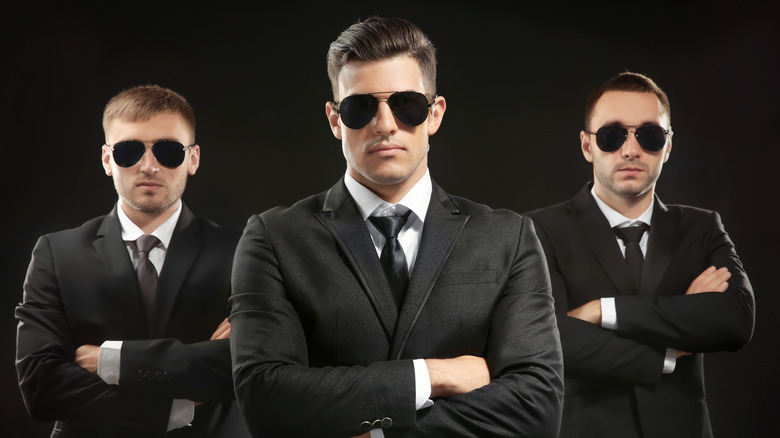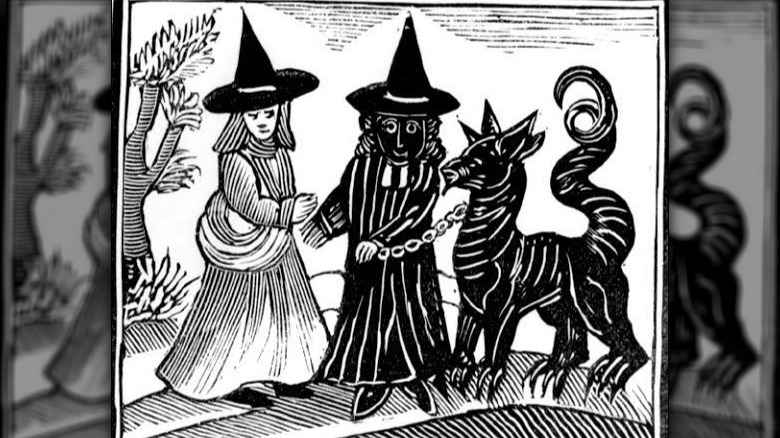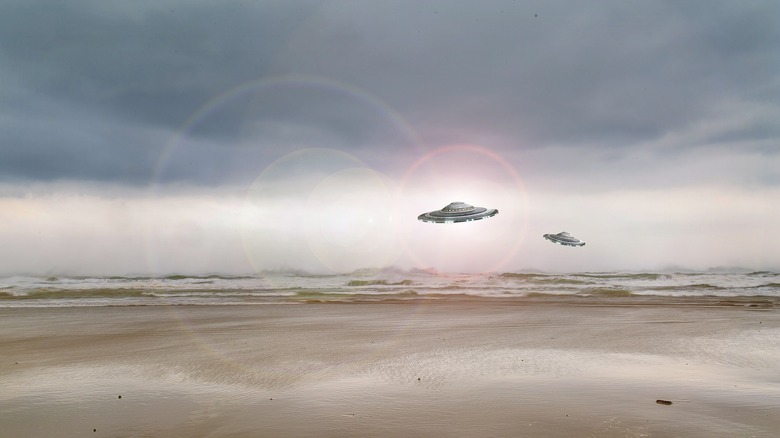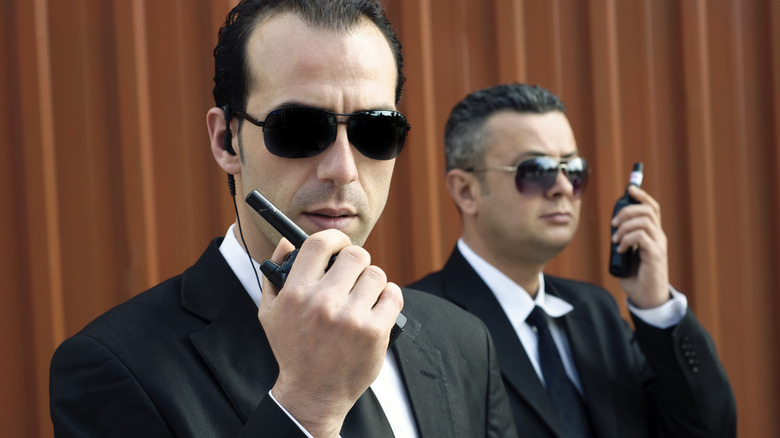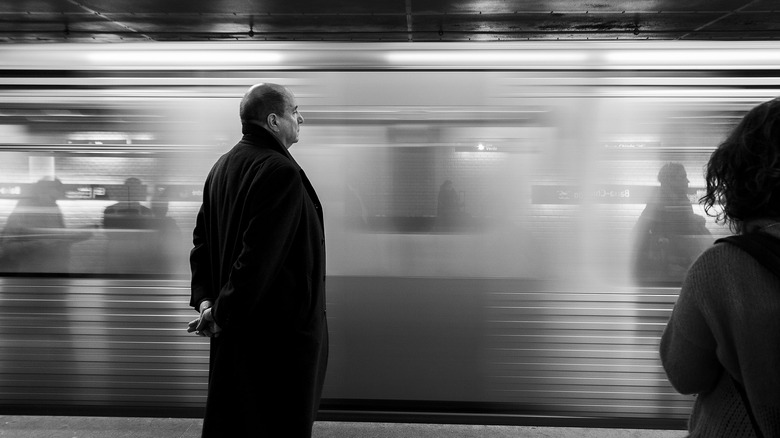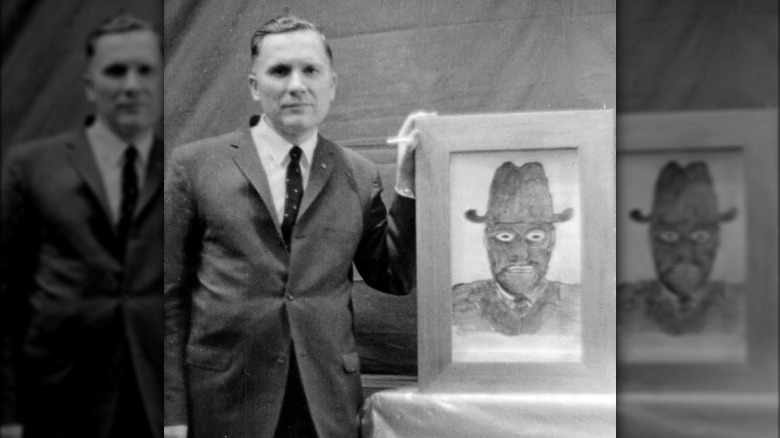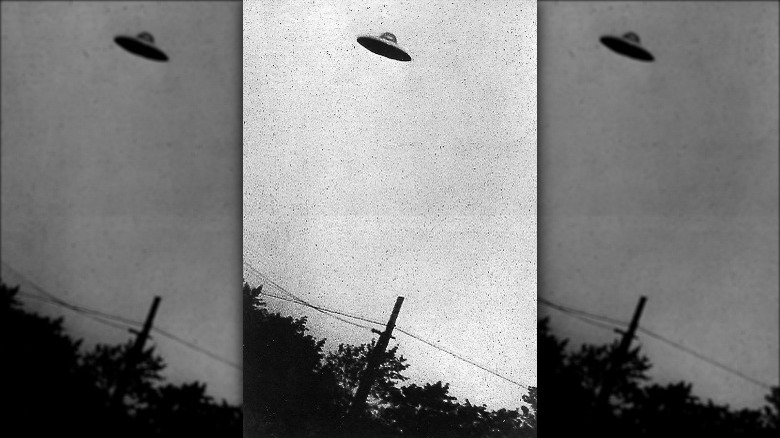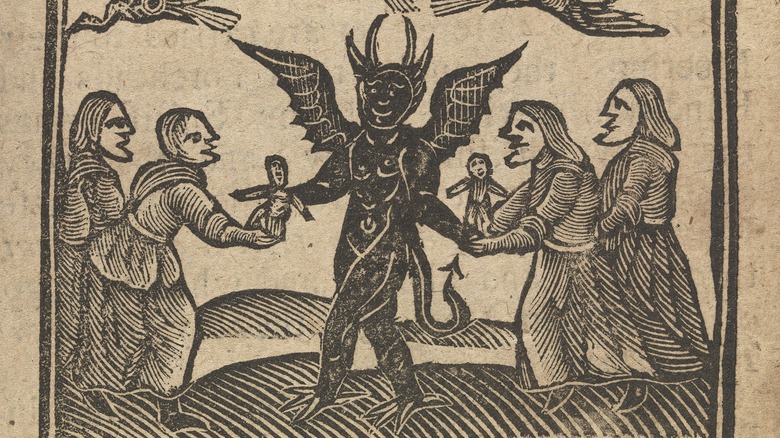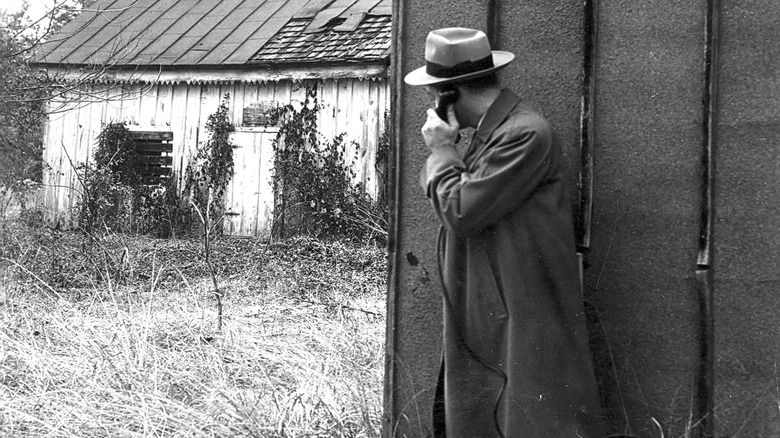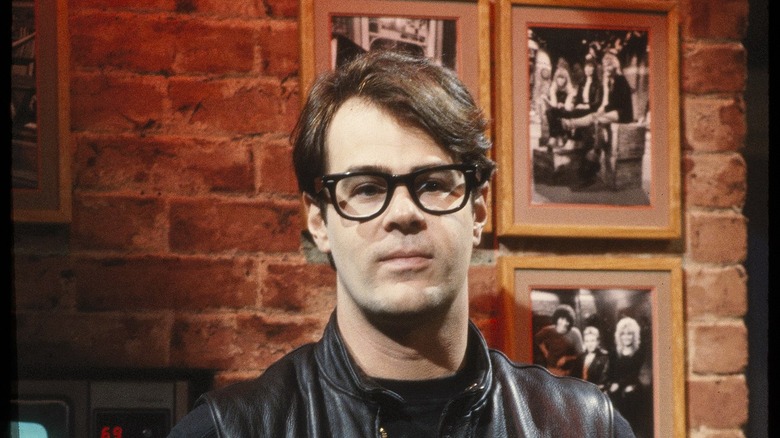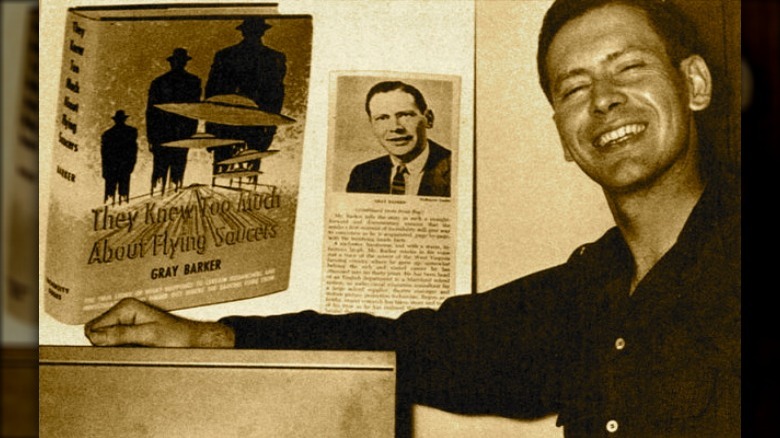The Eerie History Of The Men In Black
Let's say you see something strange in the sky. Maybe it's just an odd light moving in an unusual way. Maybe it's a full-on craft that you've never seen before, floating silently above you. Perhaps you even believe that you've had an encounter with an extraterrestrial being. You excitedly tell someone about your experience, writing a letter or posting it to the internet.
Then, the real trouble begins. Mysterious men dressed in nondescript black suits arrive without warning, unnerving you with their knowledge of the event, not to mention their vague threats of harm that might come to talkative UFO witnesses. They might act strangely or show odd abilities. Often they decline to identify themselves and leave as suddenly as they appear. It seems that you've had an encounter with the men in black. According to History, these black-suited figures have been a key feature of UFO folklore since the 1940s, typically appearing to menace witnesses into silence for their own obscure, possibly nefarious purposes.
Today, the men in black are just as much a feature of the American cultural landscape as they are a spooky series of tales connected to the modern UFO phenomenon. Consider the success of 1997's "Men in Black," starring Tommy Lee Jones and Will Smith as lovable, black-suited agents who wipe memories and clear extraterrestrials for immigration to our planet. But is that all they do? And do they even exist? For some, the eerie history of the men in black is far more sinister.
Some say men in black have been around for a long time
Though tales of the men in black began in the 1940s, some theorize that they've been around far longer. The appearance of men dressed in black clothing, behaving strangely and menacing people, applies to more than one period in history. As The Journal of American Folklore notes, there are clearly some thematic links between modern men in black and historic accounts of the Devil and other diabolical figures.
According to "Casebook on the Men in Black," quite a few people caught up in the witch panics of medieval and early modern Europe confessed that they had interacted with just such ominous figures. Most often, they pegged one as the Devil himself, such as when accused English witch Agnes Sampson said that the satanic figure she encountered was "clad in ane blac goun with ane blak hat vpon his head." Then again, given how panicked these "witnesses" may have been (especially if they were tortured), take their accounts with a grain of salt.
Author Jim Keith also draws parallels between these accounts and other hallmarks of modern UFO stories, from glowing blue light to odd marks that appear upon peoples' bodies. Even Tituba, the enslaved woman whose account of witchcraft may have kicked off the Salem Witch Trials of 1692, claimed to have encountered a mysterious man dressed all in black and with white hair, strongly implied to have been the Devil (via "Casebook on the Men in Black").
The earliest encounters came in the 1940s
The first known run-ins with modern men in black came just days after the first sighting of the UFO age. First, on June 24, 1947, aircraft pilot Kenneth Arnold reported seeing nine strange UFOs while he was flying past Mount Rainier in Washington state. He reported the sighting upon landing in nearby Yakima, reports The Atlantic, whereupon the modern age of UFO sightings and reported encounters with extraterrestrials kicked off.
The men in black weren't too far behind. On June 27, just three days after Arnold's sighting, Harold Dahl was on a boat in Washington's Puget Sound, near Maury Island. According to History, that's when he spotted six craft hovering above his boat, one of which dropped suddenly and began littering him, his son, and their dog with debris. Unlike seemingly many other UFO encounters, Dahl managed to snap a few pictures, which he showed to supervisor Fred Crisman.
Then, things got even weirder. The next day, Dahl met with a man in a black suit who was able to recount the earlier encounter in great detail. What's more, the man warned Dahl to keep his mouth shut, lest unfortunate incidents occur. And, as History Link reports, the mysterious and increasingly menacing man also ruined Dahl's photographs. Yet, Dahl and Crissman eventually confessed to hoaxing the whole thing. Despite this key detail, the "Maury Island Mystery" is often cited as the inciting event in the men in black mythos.
Another man reported an encounter after a UFO fender bender
Twenty years after Harold Dahl's (almost certainly false) account of coming across a man in black in 1940s Washington, a man named Robert Richardson had a similar encounter. According to HuffPost, Richardson was driving at night near Toledo, Ohio. Perhaps because of the low-visibility conditions, he hit a mysterious object which then seemed to disappear. At this point, you could chalk it all up to poor night vision or some other sort of impairment, except Richardson claimed to have picked up a piece of metal from the road that may have belonged to the object.
A few days later, the men in black began to show up. The first pair arrived at Richard's house late at night, wearing black suits and driving a black 1953 Cadillac. They asked questions about the encounter and then left. Another pair of men in black arrived the week after that, now wanting to take the piece of metal away. When Richardson said that he had already sent the mysterious piece away for analysis, they grew aggressive and threatened Richardson's wife if he didn't get the metal back as soon as possible. They then left, and Richardson (and his wife, thankfully) never saw the men in black again.
Men in black often look and act strangely
Over time, as more and more people began to report encounters with the inquisitive and sometimes-hostile men in black, patterns began to emerge. Whether that was the result of a genuine pattern of appearance and behavior or perhaps the proliferation of men in black tales remains up for debate. However, the themes of the men in black's appearances are weird enough to be noteworthy.
First, and most obviously, is the detail that nearly all of the reports of these figures say they're dressed in black suits. According to HuffPost, that also typically includes black hats, dark sunglasses, and black, nondescript cars. One man who had an encounter with one in 1976, Dr. Herbert Hopkins, noted that his particular man in black (who arrived alone), was oddly pale and completely free of any visible hair (including eyebrows and eyelashes). His lips, meanwhile, were strikingly red.
Other men in black are also just plain strange looking. "Casebook on the Men in Black" relates the story of one family's encounter with a man in black who wasn't just pale, but also physically large, had protuberant eyes, sported a furred hat, and had a noticeably odd and "tinny" voice. As CNN reports, this sort of strangeness has popped up in other encounters, making many wonder if the men in black aren't fully human. Or, as some suggest, it could be that they're purposefully odd in order to make believer's accounts all the more unbelievable.
Albert Bender provided a key account of the men in black
Albert K. Bender was, by all accounts, a weird guy. As the Bridgeport History Center notes, he was fond of the eerie and the macabre, decorating his room with skulls and other oddities, deeming it the "Chamber of Horrors." Now, being a proto-goth in the 1950s isn't all that bad, but things got really weird when Bender began to claim encounters with the men in black.
It began after he founded the International Flying Saucer Bureau and its journal, "Space Review," in 1952. Shortly thereafter, Bender believed that odd events began to dog him, including telepathic messages and a man with glowing eyes watching him in a theater. Things escalated when three men in black showed up at his front door, claiming to have read Bender's unpublished "Space Review" articles. "We advise those engaged in saucer work to please be very cautious," they reportedly said (via "The UFO Magazine UFO Encyclopedia").
It was enough for Bender to shut down the IFSB in 1953, though his story was later picked up by IFSB member Gray Barker and published in 1956's "They Knew Too Much About Flying Saucers," as per ctpost. Bender himself published "Flying Saucers and the Three Men" in 1962 before leaving the UFO world behind. Barker, for his part, seems to be the one who first drew connections between the Maury Island incident and Bender's experiences, hinting at an organized group of men in black (via History).
One encounter got extra menacing
According to "Weird New England," on September 11, 1976 in Old Orchard Beach, Maine, physician Dr. Herbert Hopkins was at home conducting research on UFOs and alien abductions. That evening, he received a call from someone who claimed to represent the "New Jersey UFO Research Organization" (which later turned out to not exist).
Hopkins agreed to speak with the man, but, as soon as he hung up, the caller was at the doctor's front door. What's more, not only was the man dressed in all black, but he was oddly pale, had bright red lips, and had no visible hair. When the man touched his face, the lip color even came away. The man in black began discussing the unpublished case in detail.
The visitor then said that Hopkins had two coins in his pocket. He asked the doctor to hold one and, to Hopkins' astonishment, it disappeared. The man also mentioned Barney Hill, who had famously witnessed a UFO along with his wife Betty in 1961. Hill, who had recently died from an apparent heart attack, had actually died "because he knew too much," said the man. Eventually, the man's speech slowed and, claiming that he was running low on energy, abruptly ended the strange conversation, left the house, and disappeared into a blinding light (via "True Stories of the Real Men in Black"). Hopkins subsequently destroyed his research materials.
Explanations for men in black have gotten complicated
So, who are the men in black? Maybe they're disinformation agents whose strange appearance and odd mannerisms make the stories told about them seem all the more ridiculous to skeptics. Or, wait, maybe they're plain old government agents whose bluntness was misinterpreted by socially awkward UFO nerds. Or are they actually demons?
Really, the only "truth" we can all agree on when it comes to the identity of the men in black is that we can't agree on anything. If you asked people of the more distant past — or even the less distant past — they may claim that the men in black are no less than demonic beings (via "Casebook on the Men in Black").
For those more inclined to everyday answers to this question, it could be that the men in black are actually government agents, dressed plainly and sent to scare people away from top secret projects. That's certainly what Albert K. Bender believed, according to Slate. Some take it a bit further, distinguishing between lowercase "men in black" (boring old humans) and uppercase "Men in Black," whom they claim are supernatural or extraterrestrial beings. If you accept the growing slate of stories where men in black behave strangely, then it could be that they're intelligent creatures unfamiliar with our world. Or, as Slate notes, there is a thread of xenophobia or racism in some stories, which grant the men in black "olive" skin and "exotic" features.
One photo may be linked to another men in black story
While there are some reported images of men in black, like the security camera footage that accompanies hotel manager Shane Shovar's 2008 story, you have to admit that video and photo evidence is nonetheless tough to believe. Consider, after all, that there are plenty of mundane people who like to wear dark suits and will pop on a pair of sunglasses to avoid the sun's glare. Yet, there's one unique photo that some take as more convincing evidence of the UFO phenomena and the men in black.
Known as the "Solway Firth Spaceman," the white-clad figure appeared in the background of a 1964 photo taken by a British firefighter, as the BBC reports. Though he meant only to take a picture of his young daughter, Jim Templeton later realized someone else was in the photo. For believers, it was pretty clearly a "spaceman" in a white suit and dark visor. For others, it was an overexposed, out of focus image of Templeton's wife.
The men in black came in later, appearing to Templeton and referring to each other only as "Number 9" and "Number 11," while refusing to show identification. They claimed to be government agents and asked Templeton to show them the spot where he took the picture. When Templeton eventually revealed that he hadn't seen the figure while taking the image, the pair drove away — leaving Templeton to walk home (via The Mirror).
There may be a tiny grain of truth to some stories
As Live Science notes, it's possible that early reports of men in black concerned actual government agents, perhaps connected to Project Blue Book. For those not in the know, Project Blue Book was an investigation begun in 1952 under the aegis of the U.S. Air Force. According to the New York Times, it was undertaken partially to mitigate any potential panic during the Cold War, when the idea of strange objects flying through the skies might conjure nightmares of Soviet planes loaded with death. Investigators also wanted to know if the Russians had indeed gotten ahead of the U.S. in a technological race.
Even the CIA has admitted to covering up some sightings during this time, too, as the New York Times reports. Their justification for such behavior? The Russians. During the height of the Cold War, the U.S. Air Force was developing top secret aircraft like the U-2 spy plane. Allowing the word to get out about these projects could mean that the Soviets would then have an edge in a simmering conflict that involved not only national pride, but nuclear weapons.
It could be that at least a few of those black-suited men were CIA agents desperate to keep some schmuck's sighting a goofy story and nothing more. After all, loose lips sink ships (or highly advanced espionage aircraft).
Even Dan Aykroyd claims to have had an encounter
Canadian actor Dan Aykroyd is probably best known for his roles in films like "Ghostbusters" and "The Blues Brothers," but he's branched out in recent years. Besides becoming a vodka entrepreneur with his Crystal Head Vodka and also co-founding the House of Blues series of music venues (via Business Insider), he's also something of a UFO enthusiast. To that end, through the course of his investigations, Aykroyd has claimed to have personally experienced some weird, potentially extraterrestrial encounters, including a run-in with the men in black.
According to IFC, it all more or less started with Britney Spears. Yes, really. According to Aykroyd, he was taking a break from a television shoot and speaking with Spears on the phone when he noticed a pair of the ominous men in black observing him. He looked away for a moment, only to discover that the men, who had been sitting in an SUV, had disappeared. Mere hours later, he received word that the UFO special he was taping was canceled, with no real explanation given (via The Things). Coincidence? Maybe. But Aykroyd himself at least partially blames the two men in black and whatever interests they may have represented.
There's evidence that some men in black tales were hoaxed
One of the earliest known stories of the men in black, popularly known as the Maury Island incident, was later revealed by the supposed experiencers as a fabrication, as History Link reports. And, later, one of the most prominent champions of the men in black phenomenon was connected to some serious hoaxing accusations, too.
As the Committee for Skeptical Inquiry reports, Gray Barker is a key figure in the modern development of the men in black story. As an associate of Albert K. Bender, Barker made something of a career as a UFO author in the decades after Bender's reported experiences. In the 1960s, he also corresponded with young author John C. Sherwood, who had previously established himself as the producer of a small UFO publication and whose nonfiction work about Michigan UFO sightings was published by Barker. Ultimately, however, Sherwood's fiction work was molded into "nonfiction" accounts also published by Barker, who made it clear that he had few qualms about presenting other fictional work as the supposedly real deal.
In writing to Sherwood, Barker eventually professed some level of disdain for many "saucerers," whom he believed were paranoid and neurotic — though he was happy to continue making money off said neuroses. Though it doesn't appear that he confessed outright to making up the men in black stories, Barker's involvement in the stories and his penchant for falsehoods casts a serious shadow over men in black lore.
